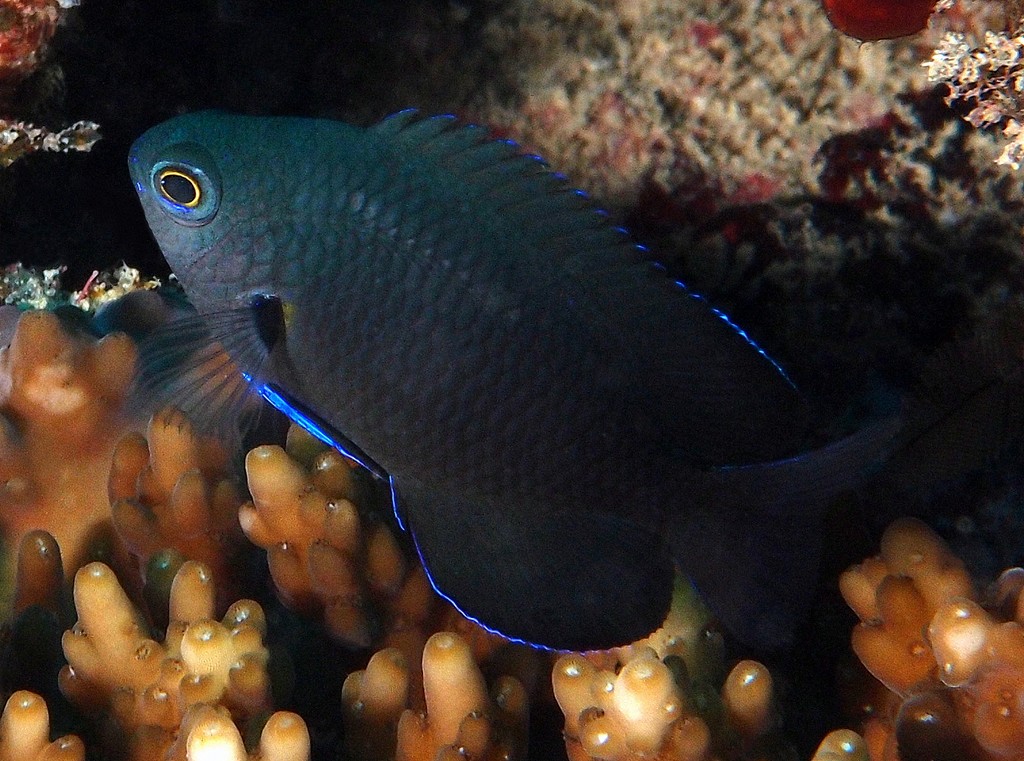POMACENTRUS BRACHIALIS - (CUVIER, 1830)
Actinopterygii (Gigaclass) > Actinopteri (Class) > Teleostei (Subclass) > Blenniiformes (Order) > Pomacentridae (Family) > Pomacentrinae (Subfamily) > Pomacentrus (Genus)
Demoiselle noire, Bar-finned damsel, Black damsel, Charcoal damsel, Charcoal damselfish, 臂雀鲷, 黑鳍雀, 黑鳍雀鲷,
Synonymes
Pomacentrus melanopterus (Bleeker, 1852)
Pseudopomacentrus rainfordi (Whitley, 1935)
------------------------
Description
Dorsal spines (total): 13; Dorsal soft rays (total): 13-15; Anal spines: 2; Anal soft rays: 14-15. Max. length: 10.5 cm TL. Depth range: 6 - 40 m.
Color
Dark grey to blackish body with a large black spot covering the pectoral fin base. Juveniles also have the pectoral fin spot and are bluish-grey with bright blue fin margins.
Etymology
Pomacentrus: from Greek, poma, -atos = cover, operculum + from Greek, kentron = something with a sharp point: point, spike, spur, sting, quill, thorn. Referring to serrations and prickles along margins of opercular bones of Pomacentrus pavo.
brachialis: from Latin, brachium, which derives from Greek, brachion = arm. Referring to black spot on the upper limb between the shoulder and the elbow.
Original description: Pomacentrus brachialis Cuvier, 1830 - Type locality: Java, Indonesia.
Distribution
Eastern Indian Ocean, western Pacific: Indonesia, east to Fiji, south to Queensland (Australia) and New Caledonia.
Biology
Adults are found in passages and outer reef slopes; Also in current prone and clear water reef flats. They occur singly or in small groups. Feed on zooplankton and benthic algae. Oviparous, distinct pairing during breeding. Eggs are demersal and adhere to the substrate. Males guard and aerate the eggs.
Similar species
Pomacentrus flavoaxillaris (Allen, Erdmann & Purtiwi, 2017) - Reported from Western Pacific: Federated States of Micronesia. Caracterised by yellow marking on the inner pectoral fin axil, a pronounced white areas at the base of the posterior dorsal and anal fins, a whitish caudal peduncle, and an overall general paler coloration of the ventral body.
Stegastes nigricans (Lacepède, 1802) - Reported from New Caledonia - Link to the species (here).
Last update: 11, July 2024
Demoiselle noire, Bar-finned damsel, Black damsel, Charcoal damsel, Charcoal damselfish, 臂雀鲷, 黑鳍雀, 黑鳍雀鲷,
Synonymes
Pomacentrus melanopterus (Bleeker, 1852)
Pseudopomacentrus rainfordi (Whitley, 1935)
------------------------
Description
Dorsal spines (total): 13; Dorsal soft rays (total): 13-15; Anal spines: 2; Anal soft rays: 14-15. Max. length: 10.5 cm TL. Depth range: 6 - 40 m.
Color
Dark grey to blackish body with a large black spot covering the pectoral fin base. Juveniles also have the pectoral fin spot and are bluish-grey with bright blue fin margins.
Etymology
Pomacentrus: from Greek, poma, -atos = cover, operculum + from Greek, kentron = something with a sharp point: point, spike, spur, sting, quill, thorn. Referring to serrations and prickles along margins of opercular bones of Pomacentrus pavo.
brachialis: from Latin, brachium, which derives from Greek, brachion = arm. Referring to black spot on the upper limb between the shoulder and the elbow.
Original description: Pomacentrus brachialis Cuvier, 1830 - Type locality: Java, Indonesia.
Distribution
Eastern Indian Ocean, western Pacific: Indonesia, east to Fiji, south to Queensland (Australia) and New Caledonia.
Biology
Adults are found in passages and outer reef slopes; Also in current prone and clear water reef flats. They occur singly or in small groups. Feed on zooplankton and benthic algae. Oviparous, distinct pairing during breeding. Eggs are demersal and adhere to the substrate. Males guard and aerate the eggs.
Similar species
Pomacentrus flavoaxillaris (Allen, Erdmann & Purtiwi, 2017) - Reported from Western Pacific: Federated States of Micronesia. Caracterised by yellow marking on the inner pectoral fin axil, a pronounced white areas at the base of the posterior dorsal and anal fins, a whitish caudal peduncle, and an overall general paler coloration of the ventral body.
Stegastes nigricans (Lacepède, 1802) - Reported from New Caledonia - Link to the species (here).
Last update: 11, July 2024
